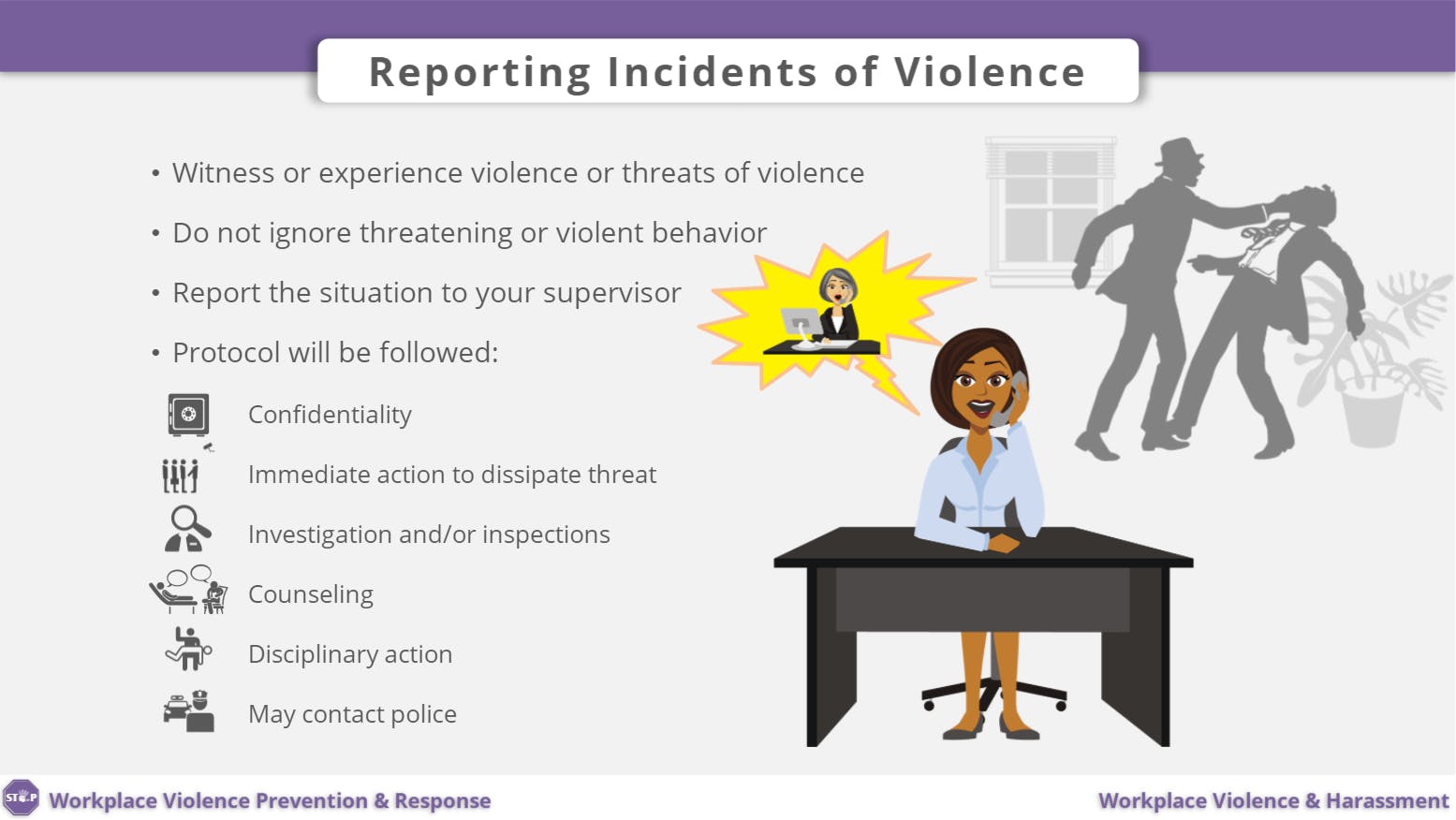The Function of Employee Training and Understanding in Enhancing Workplace Physical Violence Prevention Initiatives Throughout Numerous Industries
The combination of worker training and understanding right into work environment violence prevention initiatives is increasingly identified as a basic facet of business security across diverse industries. Recognizing these subtleties might expose methods that can considerably enhance safety methods and worker confidence in high-risk settings.
Relevance of Educating Programs
In today's dynamic workplace, the relevance of training programs can not be overstated, particularly in the context of work environment violence avoidance. These programs work as a foundational component in growing a safe and secure work environment culture. By outfitting workers with the knowledge and abilities needed to identify, minimize, and react to potential hazards, organizations can cultivate an atmosphere that focuses on security and well-being.
Efficient training programs do greater than simply instruct; they encourage staff members to recognize warning signs of violence, recognize the procedures for reporting incidents, and establish strategies to de-escalate prospective problems. They impart a feeling of cumulative responsibility amongst team, encouraging positive engagement in maintaining a safe work environment.
Financial investment in training not only improves staff member recognition but likewise shows a company's commitment to protecting its labor force. This aggressive approach can result in minimized cases of workplace violence, lower absenteeism, and enhanced staff member spirits. Inevitably, comprehensive training programs are essential to establishing a durable business society that values safety and security and advertises a healthy and balanced work environment, thus decreasing the danger of violence and its connected effects.
Key Components of Effective Recognition
A thorough recognition program incorporates a number of crucial elements that are vital for efficiently avoiding workplace violence. Clear interaction of policies and procedures associated to work environment violence is crucial. Employees have to be notified about the organization's position on violence and the particular protocols in position for reporting events.
2nd, training sessions need to integrate realistic circumstances that workers may run into. This functional method helps staff members acknowledge cautioning indications of prospective physical violence and furnishes them with the required abilities to de-escalate tense scenarios. Third, promoting a supportive office society is important; staff members must feel encouraged to talk up without concern of revenge.
In addition, recurring education and learning is essential to maintain awareness appropriate and fresh. Normal refresher programs and updates on arising threats can improve staff members' vigilance and preparedness. Finally, including feedback systems enables staff members to share their insights and experiences, which can result in constant renovation of recognition initiatives. By incorporating these parts, companies can develop a durable structure for preventing workplace violence, eventually contributing to a much safer and a lot more efficient atmosphere for all workers.
Industry-Specific Training Strategies
Reliable work environment violence prevention training have to be customized to the special difficulties and risks faced by details markets. For instance, healthcare settings need training that deals with the high possibility of experiences with hostile clients or site visitors. Programs need to focus on de-escalation techniques, identifying indication of possible violence, and making certain personnel realize the value of reporting events.
In contrast, retail setups may encounter different threats, such as break-in or client disputes. Training in these atmospheres should highlight situational recognition, reaction methods during emergency situations, and the importance of securing cash and belongings.
Manufacturing and building moved here sectors provide their very own risks, commonly connected with interpersonal conflicts or risky working conditions. Training in these sectors must consist of strategies for dispute resolution, advertising a society of safety, and motivating open interaction among staff members.
Moreover, company workplaces might call for training fixated avoiding harassment and intimidation, cultivating a respectful workplace culture, and carrying out clear coverage devices. Each industry should not only acknowledge its details susceptabilities but also adapt training materials to resonate with the workforce successfully, making sure that staff members really feel complete and encouraged to handle potential violent situations.
Measuring Training Effectiveness
Reviewing the effect of workplace violence avoidance training is vital for making sure that employees are properly prepared to handle possible dangers. Pre- and post-training surveys can assess modifications in staff member understanding, attitudes, and actions worrying office physical violence.
Additionally, sensible evaluations, such as role-playing circumstances or simulations, can offer insights into how well workers apply discovered skills in real-life circumstances. Keeping track of case reports prior to and after training can likewise act as an indication of efficiency, as a decrease in occurrences may mirror improved staff member preparedness.
In addition, feedback from participants should be methodically accumulated to determine locations for renovation in training content and shipment. Conducting follow-up analyses at regular intervals aids receive recognition and enhances training concepts in time - california workplace violence prevention. By employing a detailed approach to determining training efficiency, organizations can guarantee that their office physical violence prevention initiatives promote a more secure setting and enhance general staff member health
Building a Culture of Safety

Training plays an essential duty in this cultural shift. Regular, extensive training sessions inform staff members concerning identifying caution indicators of workplace violence and the suitable actions. Urging open communication enables workers to voice worries without anxiety of revenge, advertising collective obligation for safety.
Additionally, integrating safety and security right into daily procedures makes certain that it comes to be a common value as opposed to a plain conformity problem. This includes routine security drills, updates on policies, and responses systems reference that include employees in safety and security conversations and enhancements.
Ultimately, a durable culture of safety and security not just reduces the risks of office physical violence but additionally improves employee morale and productivity. By cultivating an atmosphere where safety is a basic concern, companies can produce resilient offices that sustain both private well-being and cumulative success.
Conclusion
In verdict, worker training and recognition are crucial components in the avoidance of work environment physical violence across numerous markets. Reliable training programs, tailored to details industry demands, enhance workers' capability to recognize and respond click now to potential dangers. By implementing detailed recognition strategies and promoting a society of security, companies can considerably minimize incidents of work environment physical violence and boost total worker morale. Commitment to continuous training and analysis guarantees sustained effectiveness and adaptability in resolving arising difficulties within the workplace atmosphere.

Regular, detailed training sessions enlighten staff members regarding acknowledging warning indications of workplace violence and the appropriate responses.In verdict, staff member training and recognition are crucial elements in the prevention of workplace physical violence throughout different industries.